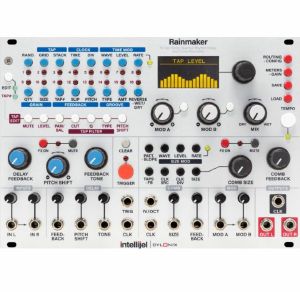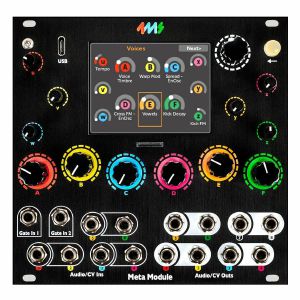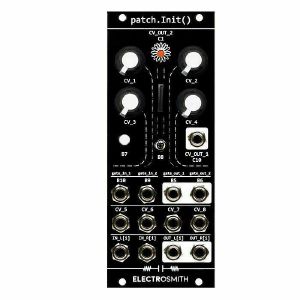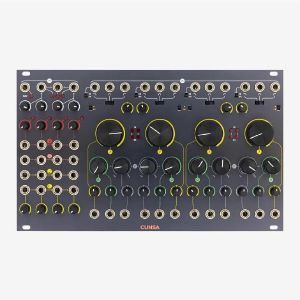Filter
Equipment
Format
Featured
Price
Tags: Effects module
Products tagged as Effects module
Items 1 to 4 of 4 on page 1 of 1
Intellijel/Cylonix Rainmaker 16-Tap Stereo Spectral Rhythm Delay & Comb Resonator Module (silver) (effect synth module)
Cat: 620692 Rel: 10 Aug 16
Stereo rhythmic delay & stereo comb resonator synth module in Eurorack format - 36 HP wide
Notes: The Intellijel/Cylonix RAINMAKER eurorack-format module provides a high-quality (96KHz sampling rate with 32-bit internal processing) stereo rhythmic delay and stereo comb resonator effect.
The stereo rhythm delay has 16 taps, each with its own resonant 2nd-order filter and granular pitch shifter. The filters have independently adjustable resonance and cutoff frequency, and can be set to either lowpass, bandpass, highpass or bypass operation. The filters are also capable of self-oscillation, enabling modal synthesis techniques. The granular pitch shifters have a range of 15 semitones up or 16 semitones down. Each tap can repeat at a rate value set in tap#'s in order to create regenerating echo effects. The feedback signal has a lowpass/highpass tone control and its own pitch shifter. The tap delay times can range from 0.1 millisecond up to a maximum of 20 seconds. The overall delay times can be set with the rotary encoder, the tap tempo button, or synced to an external clock.
The stereo comb resonator section has 64 time-delayed taps which are summed together. This produces a deep comb filter or resonating effect. At large comb sizes (long time delays) a multiple echo effect is produced. The density of the resonator can be varied from 2 to 64 taps. The tap with the longest delay time is fed back to the input. High feedback levels, with short comb sizes, produce "Karplus-Strong" types of plucked string sounds. The relative timing of the 64 taps are set according to one of 16 different preset patterns, which provide different resonator timbres or echo rhythms. The comb size can be set either with the rotary encoder, an external clock or through a transposable 1v/oct input voltage.
The Rainmaker module has extensive voltage control capabilities. Direct voltage control is available for the delay feedback level and tone, the global pitch shift for all delay taps, the comb resonator size, and comb feedback level. There are two assignable modulation inputs, which can be assigned to different parameters in each preset. A trigger input with assignable functionality can trigger built-in types of noise bursts, freeze the delay buffer, reverse the delay, randomize parameters, mute taps, and much more.
… Read moreThe stereo rhythm delay has 16 taps, each with its own resonant 2nd-order filter and granular pitch shifter. The filters have independently adjustable resonance and cutoff frequency, and can be set to either lowpass, bandpass, highpass or bypass operation. The filters are also capable of self-oscillation, enabling modal synthesis techniques. The granular pitch shifters have a range of 15 semitones up or 16 semitones down. Each tap can repeat at a rate value set in tap#'s in order to create regenerating echo effects. The feedback signal has a lowpass/highpass tone control and its own pitch shifter. The tap delay times can range from 0.1 millisecond up to a maximum of 20 seconds. The overall delay times can be set with the rotary encoder, the tap tempo button, or synced to an external clock.
The stereo comb resonator section has 64 time-delayed taps which are summed together. This produces a deep comb filter or resonating effect. At large comb sizes (long time delays) a multiple echo effect is produced. The density of the resonator can be varied from 2 to 64 taps. The tap with the longest delay time is fed back to the input. High feedback levels, with short comb sizes, produce "Karplus-Strong" types of plucked string sounds. The relative timing of the 64 taps are set according to one of 16 different preset patterns, which provide different resonator timbres or echo rhythms. The comb size can be set either with the rotary encoder, an external clock or through a transposable 1v/oct input voltage.
The Rainmaker module has extensive voltage control capabilities. Direct voltage control is available for the delay feedback level and tone, the global pitch shift for all delay taps, the comb resonator size, and comb feedback level. There are two assignable modulation inputs, which can be assigned to different parameters in each preset. A trigger input with assignable functionality can trigger built-in types of noise bursts, freeze the delay buffer, reverse the delay, randomize parameters, mute taps, and much more.
4 in stock $677.11
Click for better price!
or call +44 20 7424 1960
quote 620692
quote 620692
4ms MetaModule Virtual Patch Player Module (modular synthesiser)
Cat: 1025842 Rel: 28 Aug 24
Virtual patch player module - 26HP
Notes: The hands-on control of hardware meets the versatility of software. Bridging the gap between Eurorack and VCV Rack, the MetaModule includes over 160 built-in modules plus access to over 200 third-party options.
Supplier's Notes:
The MetaModule puts real knobs and jacks on virtual software modules. Step back from the computer and make music with hardware, while keeping the flexibility and expandability of software.
The MetaModule comes with over 160 built-in modules from 4ms Company, Befaco, HetrickCV, NonlinearCircuits, and Scanner Darkly, plus clones of popular classics such as the Mutable Instruments eurorack modules, fun physical modeling algorithms, and lots of handy utilities.
All of the included modules are also available on the computer using the free program VCV Rack. Whether you make patches on VCV Rack and transfer them to the MetaModule, or if you just create patches directly on the MetaModule, there are plenty of creative modules to inspire new ways to make music.
MetaModule Plugins
If the 160+ built-in module aren't enough, you can load more modules as plugins. Already there are over 200 modules in third-party plugins from Bogaudio, Valley, ChowDSP, NANO Modular, and the list is growing. 4ms have an SDK available to make it easy for VCV Rack plugin developers to convert their plugin to a MetaModule plugin. 4ms' licensing terms are non-restrictive: developers are welcome to distribute their plugin in any way they wish, commercially or not.
Mapping Knobs and Jacks
The MetaModule has 12 knobs that can be mapped to virtual knobs. Each knob can be mapped to up eight virtual knobs, and each mapping can have a different range and offset. You also can save a group of mappings as a Knob Set and switch between Knob Sets with the encoder. You also can map the 8 inputs and 8 outputs to virtual module jacks. Also, the MetaModule is a USB MIDI host, so you also can map MIDI CC, note, gate, and other parameters to knobs and jacks.
Expanders
There are lots of ways to customize your MetaModule. A Wifi expander allows you to wirelessly transfer patches from your computer. Add eight more knobs with the Knob expander, or buttons with the Button expander. A CV/Audio expander adds more high-resolution inputs and outputs, and the Gate In/Out expander adds not only gate jacks but also TRS MIDI and I2C.
Under the Hood
There are six CV/Audio inputs, two gate inputs, and six CV/Audio outputs. The CV/Audio jacks are all 24-bit, 48kHz DC-coupled, -10V to +10V. A USB-C jack accepts MIDI devices and thumb drives. Patches and plugins can be loaded via a USB drive or microSD Card, and internal flash memory lets you save patches you always want to come back to.
The processor is more advanced than anything 4ms has used in the past, and is among the most powerful processors found in Eurorack. Startup time and latency are blazingly fast.
Modules
160 built-in modules
Over 200 3rd-party module plugins available so far, and the ecosystem is growing
Create patches using VCV Rack or directly on MetaModule
Patches
Patches are loaded from microSD Card, USB drive, or via the Wifi expander
Patches can be optionally saved onto internal flash memory
Create patches using VCV Rack or directly on MetaModule
Patches can be given a name and description
Mappings
Map each physical knob to up to 8 virtual knobs
Set range and offset for each mapping, including inverted control
Knob mappings are grouped into Knob Sets, and changing Knob Sets can be done quickly without menu-diving
Map physical jacks to virtual jacks, seamlessly making splits/mults
Add or edit modules, cables, and mappings in real-time while the patch is playing
Create alias names for mappings like "Kick Drum Level"
Interface
Simple, intuitive graphical interface lets you zoom in on details, or zoom out to get a big picture
Patch View displays the patch as faceplates and cables, with knobs, buttons, and lights animating in real-time
Knob Set View simplifies the display, showing only the mapped knobs for the current Knob Set
Module View shows just one module and lists the names of each jack, knob, and control legibly
Mapping View lets you adjust details of a knob mapping
Adjust styles and visual preferences to your liking
Save, rename, duplicate, and delete patches
Firmware updater and plugin loader read from microSD Card or USB drive
Hardware
12 Knobs
8 CV/Audio outputs, 24-bit 48kHz, -10V to +10V, DC-coupled
6 CV/Audio inputs, 24-bit 48kHz, -10V to +10V, DC-coupled
2 Gate inputs
USB-C jack: MIDI Host or MSC (External drive) Host
microSD Card slot
Internal Flash RAM for additional patch storage
Dual-core 800MHz Cortex-A7 plus Cortex-M4 co-processor
512MB DDR3 533MHz RAM
Bare-metal operation for fast startup and low latency
26hp
… Read moreSupplier's Notes:
The MetaModule puts real knobs and jacks on virtual software modules. Step back from the computer and make music with hardware, while keeping the flexibility and expandability of software.
The MetaModule comes with over 160 built-in modules from 4ms Company, Befaco, HetrickCV, NonlinearCircuits, and Scanner Darkly, plus clones of popular classics such as the Mutable Instruments eurorack modules, fun physical modeling algorithms, and lots of handy utilities.
All of the included modules are also available on the computer using the free program VCV Rack. Whether you make patches on VCV Rack and transfer them to the MetaModule, or if you just create patches directly on the MetaModule, there are plenty of creative modules to inspire new ways to make music.
MetaModule Plugins
If the 160+ built-in module aren't enough, you can load more modules as plugins. Already there are over 200 modules in third-party plugins from Bogaudio, Valley, ChowDSP, NANO Modular, and the list is growing. 4ms have an SDK available to make it easy for VCV Rack plugin developers to convert their plugin to a MetaModule plugin. 4ms' licensing terms are non-restrictive: developers are welcome to distribute their plugin in any way they wish, commercially or not.
Mapping Knobs and Jacks
The MetaModule has 12 knobs that can be mapped to virtual knobs. Each knob can be mapped to up eight virtual knobs, and each mapping can have a different range and offset. You also can save a group of mappings as a Knob Set and switch between Knob Sets with the encoder. You also can map the 8 inputs and 8 outputs to virtual module jacks. Also, the MetaModule is a USB MIDI host, so you also can map MIDI CC, note, gate, and other parameters to knobs and jacks.
Expanders
There are lots of ways to customize your MetaModule. A Wifi expander allows you to wirelessly transfer patches from your computer. Add eight more knobs with the Knob expander, or buttons with the Button expander. A CV/Audio expander adds more high-resolution inputs and outputs, and the Gate In/Out expander adds not only gate jacks but also TRS MIDI and I2C.
Under the Hood
There are six CV/Audio inputs, two gate inputs, and six CV/Audio outputs. The CV/Audio jacks are all 24-bit, 48kHz DC-coupled, -10V to +10V. A USB-C jack accepts MIDI devices and thumb drives. Patches and plugins can be loaded via a USB drive or microSD Card, and internal flash memory lets you save patches you always want to come back to.
The processor is more advanced than anything 4ms has used in the past, and is among the most powerful processors found in Eurorack. Startup time and latency are blazingly fast.
Modules
160 built-in modules
Over 200 3rd-party module plugins available so far, and the ecosystem is growing
Create patches using VCV Rack or directly on MetaModule
Patches
Patches are loaded from microSD Card, USB drive, or via the Wifi expander
Patches can be optionally saved onto internal flash memory
Create patches using VCV Rack or directly on MetaModule
Patches can be given a name and description
Mappings
Map each physical knob to up to 8 virtual knobs
Set range and offset for each mapping, including inverted control
Knob mappings are grouped into Knob Sets, and changing Knob Sets can be done quickly without menu-diving
Map physical jacks to virtual jacks, seamlessly making splits/mults
Add or edit modules, cables, and mappings in real-time while the patch is playing
Create alias names for mappings like "Kick Drum Level"
Interface
Simple, intuitive graphical interface lets you zoom in on details, or zoom out to get a big picture
Patch View displays the patch as faceplates and cables, with knobs, buttons, and lights animating in real-time
Knob Set View simplifies the display, showing only the mapped knobs for the current Knob Set
Module View shows just one module and lists the names of each jack, knob, and control legibly
Mapping View lets you adjust details of a knob mapping
Adjust styles and visual preferences to your liking
Save, rename, duplicate, and delete patches
Firmware updater and plugin loader read from microSD Card or USB drive
Hardware
12 Knobs
8 CV/Audio outputs, 24-bit 48kHz, -10V to +10V, DC-coupled
6 CV/Audio inputs, 24-bit 48kHz, -10V to +10V, DC-coupled
2 Gate inputs
USB-C jack: MIDI Host or MSC (External drive) Host
microSD Card slot
Internal Flash RAM for additional patch storage
Dual-core 800MHz Cortex-A7 plus Cortex-M4 co-processor
512MB DDR3 533MHz RAM
Bare-metal operation for fast startup and low latency
26hp
5 in stock $570.90
Click for better price!
or call +44 20 7424 1960
quote 1025842
quote 1025842
ElectroSmith patch.Init() Multifaceted Stereo DSP Platform Module (digital/dual/stereo/effect/oscillator/random/sampling synth mdoule)
Cat: 862801 Rel: 21 Mar 22
The patch.Init() is an exploratory modular interface for the Daisy Patch Submodule.
Notes: If you can code it, you can make it.
The patch.Init() is ElectroSmith's exploratory modular interface for the Daisy Patch Submodule. Open-source both in hardware and firmware, the patch.Init() is the perfect jumping off point for your next modular DSP project. From ethereal reverbs, glitchy processors, comprehensive samplers, and complex oscillators, the patch.Init() can be any module you need it to be. Looking to create your own commercial module? The front panel design is completely open-source (MIT). Just create your interface, add the Patch Submodule to the back, and you are off to the races with industry leading specs in an accessible, affordable package.
The patch.Init() comes with x1 Daisy Patch Submodule.
Check out the Patch Submodule here.
Get the Design Files here.
Eurorack development platform for the Daisy Patch Submodule
High Fidelity Daisy architecture: 24-bit, 96kHz sample-rate, 64MB SDRAM, STM32 H7 processor
Stereo I/O
Utilitarian design, with code-matching front panel parameter names
Tech Specs
Width: 10HP
Depth: 31mm
Power Consumption*: +12V=90mA, -12V=5mA, +5V=0mA
*Power consumption is firmware dependent
… Read moreThe patch.Init() is ElectroSmith's exploratory modular interface for the Daisy Patch Submodule. Open-source both in hardware and firmware, the patch.Init() is the perfect jumping off point for your next modular DSP project. From ethereal reverbs, glitchy processors, comprehensive samplers, and complex oscillators, the patch.Init() can be any module you need it to be. Looking to create your own commercial module? The front panel design is completely open-source (MIT). Just create your interface, add the Patch Submodule to the back, and you are off to the races with industry leading specs in an accessible, affordable package.
The patch.Init() comes with x1 Daisy Patch Submodule.
Check out the Patch Submodule here.
Get the Design Files here.
Eurorack development platform for the Daisy Patch Submodule
High Fidelity Daisy architecture: 24-bit, 96kHz sample-rate, 64MB SDRAM, STM32 H7 processor
Stereo I/O
Utilitarian design, with code-matching front panel parameter names
Tech Specs
Width: 10HP
Depth: 31mm
Power Consumption*: +12V=90mA, -12V=5mA, +5V=0mA
*Power consumption is firmware dependent
2 in stock $219.07
Click for better price!
or call +44 20 7424 1960
quote 862801
quote 862801
Frap Tools Cunsa Quad Analogue Pingable Multi-Mode Resonant Filter/Saturator/Mixer/Oscillator Module (effect/filter/mixer/oscillator/quad/VCA synth module)
Cat: 945399 Rel: 28 Nov 23
A quadruple analogue pingable multimode resonant filter, saturator, mixer and oscillator module in HP.
Notes: Oof. Frap casually serve up one of the best filters we've seen in a long time. Quad multimode circuits with saturation and feedback give you extensive routing options. Delicious.
Supplier's Notes:
cunsa /'cu?nsa/ s.f. [dialect of Modena of uncertain etymology, probably from a Latin *comptiare, derived from comptus, participle of comere 'organize,' 'decorate'] i curing, seasoning (of foods), tanning (of leathers).
Seasoning is crucial for cooking. It is a process that enhances the flavors, glues the ingredients together, and even adds some unexpected kick.
From a gentle refining touch to a shovelful of spice, CUNSA is the perfect seasoning tool for your patches. It can sweeten a sour lead or beef up an insipid bass line, and anything in between.
And, just like a good oil, you can even taste it by itself!
CUNSA is a quadruple analog pingable multimode resonant filter, saturator, mixer, and oscillator.
It is Frap Tools' sound seasoning tool: it can gently even a patch, applying a final touch, or it can set it on fire with a ridiculous amount of spice. It's up to you and your cooking style!
It consists of four multimode resonant filters with a custom saturation and feedback control that you can use independently or in various combinations and roles thanks to a series of seminormalizations.
Four Analogue Resonant Multimode Filters
CUNSA features four state-variable filters that can be used independently or linked and mixed. Each filter provides three behaviors simultaneously: lowpass, bandpass, and highpass. Each behavior has a 12 dB/oct slope, except for the lowpass, which can be either 12 or 24 dB/oct.
Unique 'Character' Circuit for Feedback and Distortion
CUNSA handles feedback and gain staging with extreme control and versatility. Besides the usual Q control that emphasizes the cutoff frequency, the Character circuit defines the amount of soft clipping when the filter overloads. High clipping guarantees a controlled behavior with fat tone and pure resonance, while low or no clipping lets the signal saturate the filter stages and make it scream.
V/oct Tracking and Quadruple Oscillator
Each filter responds to the V/oct signal with excellent tracking. It is thus possible to move the cutoff frequency along with the main melody or make CUNSA resonate with no input and transform it into a multiple oscillator. The V/oct inputs are seminormalled so you can control more filters with the same CV. Easy chords stabs!
Ping and Ring
CUNSA is ideal for percussive and organic tones. The Ping circuit offers a behavior similar to the BRENSO but AC-coupled. Instead of shooting the frequency to the moon with any trig, CUNSA gently responds to different incoming gates with a selectable decay curve. The Ping circuit can thus create natural decay sounds when fed with trigs or smoother envelopes with any other voltage, like a linear integrator with a custom decay.
Besides this, you can also feed the filter's audio input with trigs and make it ring at high Q settings.
Linked or Individual Filtering
The four filters can work independently or arranged in groups through seminormalled inputs and sum outputs. CUNSA can thus be a 4×1, 2×2, or a massive 1×4 filter. Even odd configurations are possible, like 1+2+1 or 3+1. Mono, stereo, or quadraphonic audio is at your fingertips.
Filter and Combo Behaviour
When the filter behavior is set to COMBINED, every control of the cutoff frequency also affects the input VCA, reducing the signal amplitude and saturation as it approaches the lowest range. It can make organic decays with the ping circuit or tame the low range at high Q and Character settings.
Four Seminormalizations for Group Use
Four inputs have a cascaded seminormalization: audio inputs, VCA CV, V/oct, and Ping. Every signal patched to a filter will thus feed also those at its right, making simultaneous use even simpler. To remove a seminormalization, simply patch a dummy cable to the corresponding input.
Analog Mixing Stage and Group Outputs
Every filter output can be routed to an analogue mix bus that sums the four filters and outputs them in three combinations: all, 1+2, and 3+4. These outputs allow for versatile audio processing. Just like we did with FUMANA, we added a gentle shelving EQ for the higher frequencies of the All output to provide additional timbral variety.
CV Inputs with Attenuators
Besides the seminormalled inputs, every filter features additional CV inputs for cutoff frequency, Q, and Character, each with a dedicated attenuverter.
… Read moreSupplier's Notes:
cunsa /'cu?nsa/ s.f. [dialect of Modena of uncertain etymology, probably from a Latin *comptiare, derived from comptus, participle of comere 'organize,' 'decorate'] i curing, seasoning (of foods), tanning (of leathers).
Seasoning is crucial for cooking. It is a process that enhances the flavors, glues the ingredients together, and even adds some unexpected kick.
From a gentle refining touch to a shovelful of spice, CUNSA is the perfect seasoning tool for your patches. It can sweeten a sour lead or beef up an insipid bass line, and anything in between.
And, just like a good oil, you can even taste it by itself!
CUNSA is a quadruple analog pingable multimode resonant filter, saturator, mixer, and oscillator.
It is Frap Tools' sound seasoning tool: it can gently even a patch, applying a final touch, or it can set it on fire with a ridiculous amount of spice. It's up to you and your cooking style!
It consists of four multimode resonant filters with a custom saturation and feedback control that you can use independently or in various combinations and roles thanks to a series of seminormalizations.
Four Analogue Resonant Multimode Filters
CUNSA features four state-variable filters that can be used independently or linked and mixed. Each filter provides three behaviors simultaneously: lowpass, bandpass, and highpass. Each behavior has a 12 dB/oct slope, except for the lowpass, which can be either 12 or 24 dB/oct.
Unique 'Character' Circuit for Feedback and Distortion
CUNSA handles feedback and gain staging with extreme control and versatility. Besides the usual Q control that emphasizes the cutoff frequency, the Character circuit defines the amount of soft clipping when the filter overloads. High clipping guarantees a controlled behavior with fat tone and pure resonance, while low or no clipping lets the signal saturate the filter stages and make it scream.
V/oct Tracking and Quadruple Oscillator
Each filter responds to the V/oct signal with excellent tracking. It is thus possible to move the cutoff frequency along with the main melody or make CUNSA resonate with no input and transform it into a multiple oscillator. The V/oct inputs are seminormalled so you can control more filters with the same CV. Easy chords stabs!
Ping and Ring
CUNSA is ideal for percussive and organic tones. The Ping circuit offers a behavior similar to the BRENSO but AC-coupled. Instead of shooting the frequency to the moon with any trig, CUNSA gently responds to different incoming gates with a selectable decay curve. The Ping circuit can thus create natural decay sounds when fed with trigs or smoother envelopes with any other voltage, like a linear integrator with a custom decay.
Besides this, you can also feed the filter's audio input with trigs and make it ring at high Q settings.
Linked or Individual Filtering
The four filters can work independently or arranged in groups through seminormalled inputs and sum outputs. CUNSA can thus be a 4×1, 2×2, or a massive 1×4 filter. Even odd configurations are possible, like 1+2+1 or 3+1. Mono, stereo, or quadraphonic audio is at your fingertips.
Filter and Combo Behaviour
When the filter behavior is set to COMBINED, every control of the cutoff frequency also affects the input VCA, reducing the signal amplitude and saturation as it approaches the lowest range. It can make organic decays with the ping circuit or tame the low range at high Q and Character settings.
Four Seminormalizations for Group Use
Four inputs have a cascaded seminormalization: audio inputs, VCA CV, V/oct, and Ping. Every signal patched to a filter will thus feed also those at its right, making simultaneous use even simpler. To remove a seminormalization, simply patch a dummy cable to the corresponding input.
Analog Mixing Stage and Group Outputs
Every filter output can be routed to an analogue mix bus that sums the four filters and outputs them in three combinations: all, 1+2, and 3+4. These outputs allow for versatile audio processing. Just like we did with FUMANA, we added a gentle shelving EQ for the higher frequencies of the All output to provide additional timbral variety.
CV Inputs with Attenuators
Besides the seminormalled inputs, every filter features additional CV inputs for cutoff frequency, Q, and Character, each with a dedicated attenuverter.
1 in stock $949.31
Items 1 to 4 of 4 on page 1 of 1

 USD
USD








